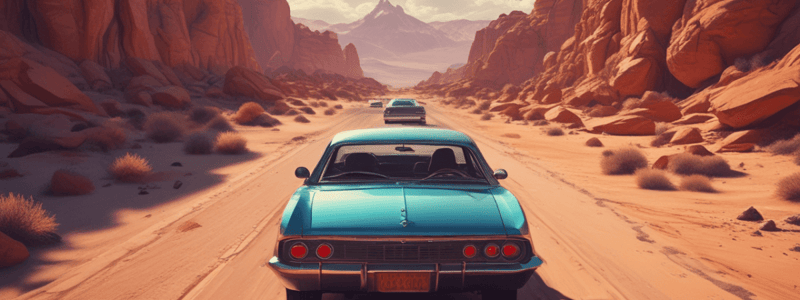Podcast
Questions and Answers
What is the main purpose of lighting in film?
What is the main purpose of lighting in film?
- To create its own shadows
- To create shadows
- To communicate and set the scene (correct)
- To create contours
What type of lighting uses the key light and fill light to make the scene more bright and open?
What type of lighting uses the key light and fill light to make the scene more bright and open?
- High key lighting (correct)
- Low key lighting
- Natural lighting
- Back lighting
What is the purpose of the fill light in a frame?
What is the purpose of the fill light in a frame?
- To counter the key light (correct)
- To create contours
- To create its own light source
- To create shadows
What type of shot shows the entire subject?
What type of shot shows the entire subject?
What is the camera angle that makes the subject seem larger and more powerful?
What is the camera angle that makes the subject seem larger and more powerful?
What is the component of visual design that includes the use of props?
What is the component of visual design that includes the use of props?
What is the main difference between film and theater lighting?
What is the main difference between film and theater lighting?
What is the type of lighting that uses fewer light sources and creates sharp contrasts?
What is the type of lighting that uses fewer light sources and creates sharp contrasts?
What is the purpose of the back light in a frame?
What is the purpose of the back light in a frame?
What is the component of visual design that includes the use of blocking?
What is the component of visual design that includes the use of blocking?
Flashcards are hidden until you start studying
Study Notes
Visual Design Elements
- Visual design refers to what is seen on the screen or inside the frame
- Components of visual design include:
- Performance
- Blocking
- Lighting
- Costume
- Set/design
- Props
Film vs. Theater Lighting
- In film, lighting is used to communicate and set the scene
Types of Lighting
- Key light: brightest light source, hits the side or front of the subject, most prominent light in a frame
- Fill light: counters the key light, usually at an angle of 60 degrees, fills in "shadows", doesn't create its own shadow, less powerful
- Back lighting/Hair light: edge light to the rear of the subject, adds contour, behind the subject, "kicker"
Lighting Styles
- High key/soft lighting: use of key light and fill light, makes the scene more bright and open
- Low key/hard lighting: fewer light sources, lots of shadows, sharp contrasts between dark and light
Light Sources
- Natural lighting: modifying natural light, such as the sun and moon
- Motivated lighting: using lamps, light bulbs, flashlights to light a scene
Cinematography
Camera Frame
- Close-up shot: face and neck
- Long shot: entire subject
- Medium shot: waist up
Camera Angle
- Low/superior angle shot: camera positioned below, subject appears larger and more powerful
- High/inferior angle shot: camera positioned above, subject appears smaller and weaker
- Eye level shot: camera at eye level, neutral perspective
Camera Movement
- Pan: stationary camera, moves left to right at a fixed angle
- Tilt: stationary camera, moves down-up
- Zoom: stationary camera, changes focal length
- Dolly: camera moves in a person's hands, in a helicopter, follows the subject in every way
Sound Design
- Components of sound design include:
- Sound effects
- Dialogue editing
- Music
- Diegetic sound: sound originates from within the scene, seen in the frame (e.g. tweeting sound from a bird)
- Non-diegetic sound: sound does not originate from within the scene, not seen in the frame (e.g. ticking clock sound with no clock in the frame)
Studying That Suits You
Use AI to generate personalized quizzes and flashcards to suit your learning preferences.



